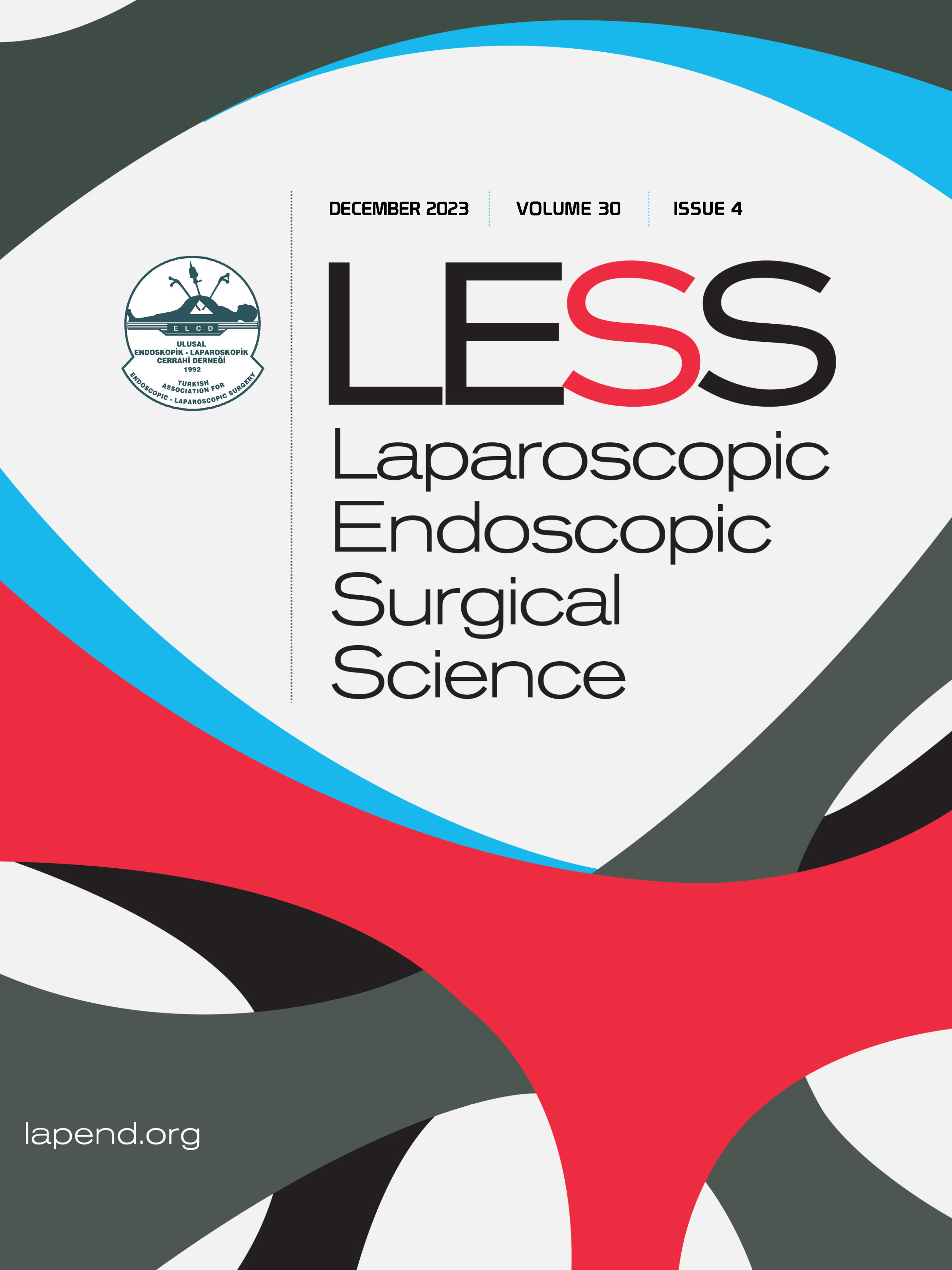Volume: 14 Issue: 1 - 2007
| REVIEW | |
| 1. | Videoanoscope Assisted Stapled Hemorrhoidopexy: First in the World Ali Doğan Bozdağ, Okay Nazlı, Tuğrul Tansuğ, Hayrullah Derici, Cemal Kara, Alper Sözütek Pages 7 - 15 Stapled hemorrhoidopexy has become an alternative method to conventional surgery in recent years. To perform the technique ideally, the purse string suture have to be placed circular and at a constant distance from linea dentata with suitable thickness of rectal mucosa. Unsuitable purse string suture may not be circular, may catch deeper tissues or some parts of the suture may be closer to linea dentata, and these factors may increase the risk persistent pain, and incontinence. Various anoscopes are modified to prevent the difficulties in purse string suturing. The stapled hemorrhoidopexy procedure was first performed in 2001 in our clinic and then the modification of the anoscope was required. The experience after the first modifications of the anoscope encouraged us to produce a more spesific anoscope. The opening of this new anoscope is adjustable by pulling the sliding lid. Additionally, it is possible to get the view inside of the anoscope, and the procedure can be viewed on a monitor. Moreover it has some advantages such as recording the operation by its videoanoscope, and these records may be useful for surgical training. |
| RESEARCH ARTICLE | |
| 2. | Laparoscopic Resection in Surgical Colorectal Diseases: Presentation of Initial 26 Cases Atilla Kurt, Mehmet Tekinel, Serdar Aksoy, Hakan Yanar Pages 16 - 22 INTRODUCTION: Especially in oncologic diseases of colon and rectum, laparoscopic approaches can be performed with safe margins. For this reason in previous studies shown that laparoscopic approaches may be more attractive than the open surgical procedures. We planned our study for evaluate the results of operated 26 patients who had malign and bening colon and rectum diseases. METHODS: Between September 2002-March 2006, we performed laparoscopic colon resections in 26 patients with colorectal cancer or operative bening colon diseases. All the operations were performed by the same surgical team. Operation time, lenght of stay, complications and pathologic findings were evaluated. RESULTS: Twenty six patients consisted of 12 male and 14 female, whose mean age was 60 (35-81), 11 of these patients had sigmoid tumors, 5 of them had rectum tumors, 2 of them had caecum tumors, one of them had dolicosigmoid disease, one of them had caecum adenoma. They were all operated. The mean operating time was 160 minutes. The postoperative lenght of stay ranged 3-16 days with a mean of 6 days. The mean number of lymphs nodes removed was 22. There were 1 operation conversion to open surgery because of fibrous adhesions, jejunal injury was performed in 1 patient during the operation. DISCUSSION AND CONCLUSION: We observed in our patients that morbidty, lenght of hospital stay, satisfaction of patients, and return of their physical and social life was gladness. Our conversion of open surgery and complication rates was harmonic with the literature. |
| 3. | Laparoscopic Cholecystectomy and Tissue Injury: Using Monopolar Electrosurgery vs Ultrasonic Energy Erdinç Kamer, Haluk R. Ünalp, Mehmet Cıkla, Taner Akgüner, Mehmet A. Önal Pages 23 - 28 INTRODUCTION: In this study we aimed to correspond tissue destruction after ultrasound energy and monopolar electroenergy laparoscopic cholecystectomy. METHODS: In this prospective nonrandomized trial we used harmonic cutter and clip for 20 (%40) of 50 patients and monopolar electrosurgery and flip for the other 30 (%60) patients to apply elective laparoscopic cholecystectomy operation. Postoperative inflammatory process and tissue destruction were evaluated with different laboratory tests (C-reactive protein, stereoid, haptoglobuline etc). RESULTS: In this study there were statistically significant differences in C-reactive protein, stereoid and haptoglobuline levels between two groups (<0.05). But there were no statistically significant differences in glucose, lakate dehidrogenase, gamma glutamik transferase, alkaline fosfatase, serum glutamic oxaloacetic transaminase, and serum glutamic pyruvic transaminase levels between two groups. DISCUSSION AND CONCLUSION: Ultrasonic energyuse in laparoscopic cholecystectomy with its advantages of less tissue easy dissection no electrical current leakage less immunosupression is a god alternative for monopolor electrosurgery in laparoscopic cholecystectomy. But the severity of trauma of surgery is not enough to evaluate the differences. The expected advantages of ultrasonic surgery for decreasing the inflammatory process have to ve supported by trails using advanced laparoscopic surgeries. |
| 4. | Why We Convert to Open Surgery in Laparoscopic Surgery? Ediz Altınlı, Atilla Çelik, Neşet Köksal, Hüseyin Kadıoğlu, Fulya Özkal, Derya Karapınar, Rüştü Kurt Pages 29 - 34 INTRODUCTION: The aim of study is to investigate conversion rates and reasons for the patients whome had been operated laparoscopically between 2002-2007. METHODS: Patients records were reviewed for five years period whom were started laparoscopically for the operations. Conversion rates and reason were classified for all operative groups. RESULTS: Laparoscopic procedures were done in 411 patients and a switch to convertion in 37 patients. Conversion rate was 9% for all laparoscopic interventions. The operative procedures converted to open procedures were 3 appendectomies, 9 colorectal resections, 1 band gastroplasty, 1 Nissen fundoplication, 1 ventral hernia repair, 2 total extraperitoneal groin hernia repairs (TEP), 11 cholecystectomies and 9 other laparoscopic interventions. Reasons for the conversion were dense adhesions, inoppropriate or false preoperative radiological staging, insufficient exposure, bleeding and technical problems. DISCUSSION AND CONCLUSION: Experience of the operation team, complete and accurate preoperative radiological staging and adequate technical equipments are main factors in prevention of conversions for laparoscopic procedures to open procedure. |
| 5. | Long Term Following Results in Laparoscopic Repair of Hernia Faruk Aksoy, Ahmet Tekin, Tevfik Küçükkartallar, Celalettin Vatansev, Metin Belviranlı, Murat Çakır Pages 35 - 40 INTRODUCTION: The only treatment of inguinal hernia is surgery and its history is old as surgerys history an excellent surgical procedure hasnt been developed. Many surgical technique is applied, according to types of patient hernia and its type and preference of the surgeon. The aim is to find best operation method and low recurrence rate. As laparoscopic surgical approac improvement was surgical increased after 1990s. Laparoscopic hernia repair is an alternative and different method. While this new surgical techniques arent suitable for some patients. For some patients, laparoscopic hernia repair is preferable, in this article we aimed to present long-term following results in laparoscopic hernia surgery in 144 patient. METHODS: The records of 144 groin hernia patients for whom we applied laparoscopic TEP hernia repair at Selcuk University Meram Medicine Faculty General Surgery Department during 1996-2004, were examined retrospectively. RESULTS: 120 of the cases were male and 9 were female. Mean ages were 43.8 (15-82) for men and 38.8 (29-60) for women. At 9 of the cases, hernia repair had been performed with anterior approach before. At 15 of cases, hernias were bilateral. The operation periods were 55 minutes (25-95) for unilateral hernias and 75 minutes (60-145) for bilateral ones. At 8 of the cases (6%), open method had to be used. DISCUSSION AND CONCLUSION: Being able to cover all potential hernia areas is one of the advantages belonging to laparoscopic hernia repair. When the long term results are examined, complication and recurrence rates decrease with inceasing experince at TEP mesh hernioplasty. |















